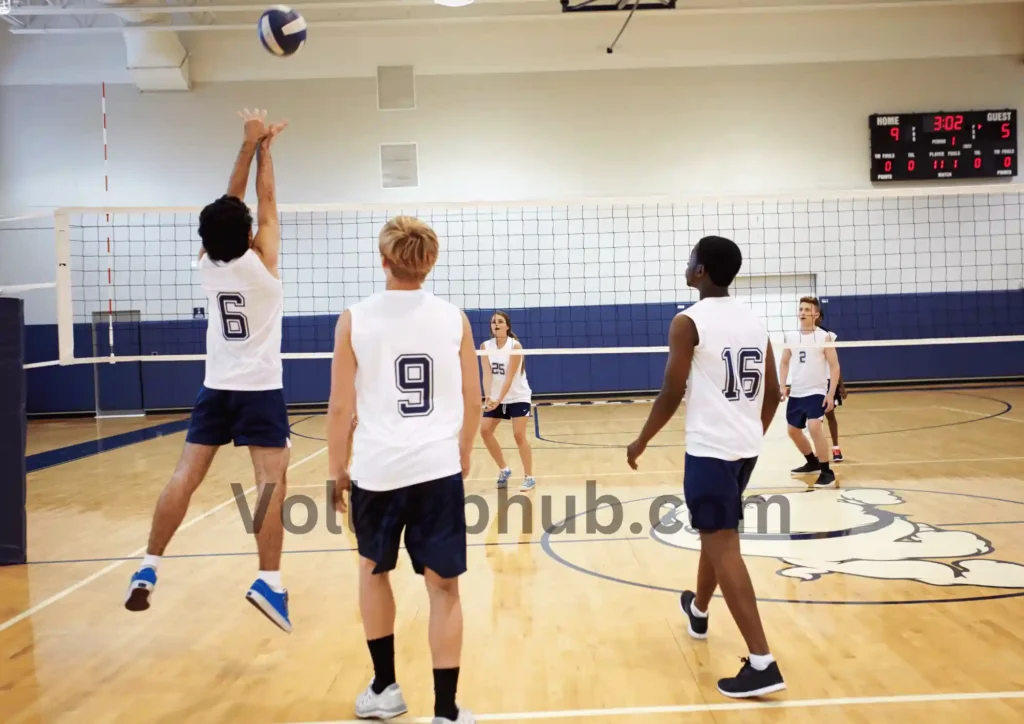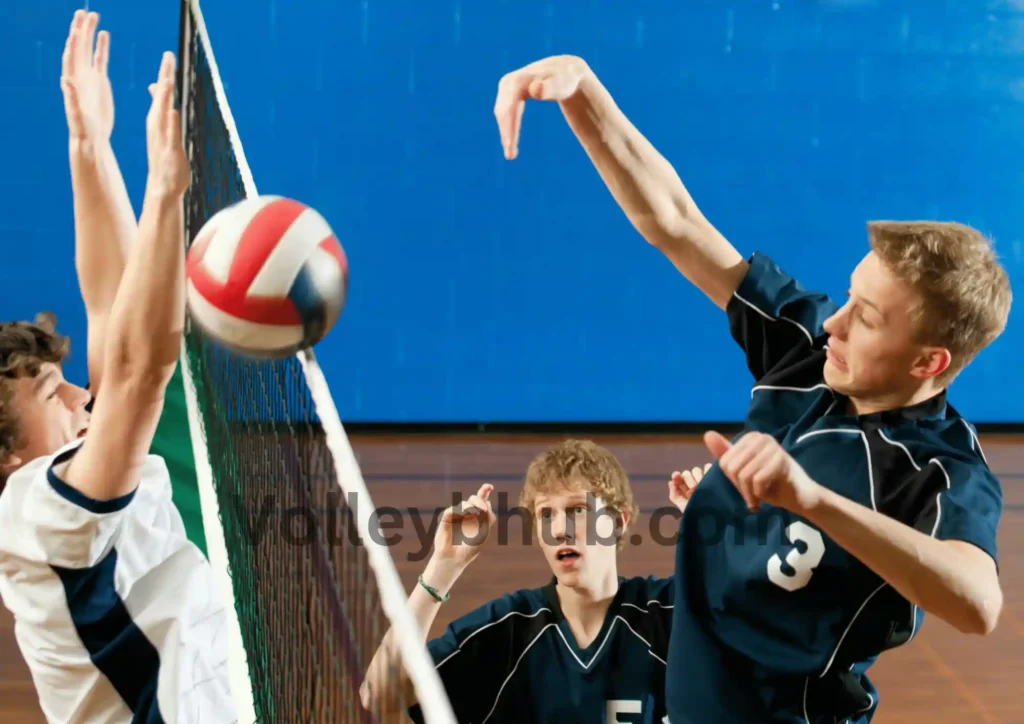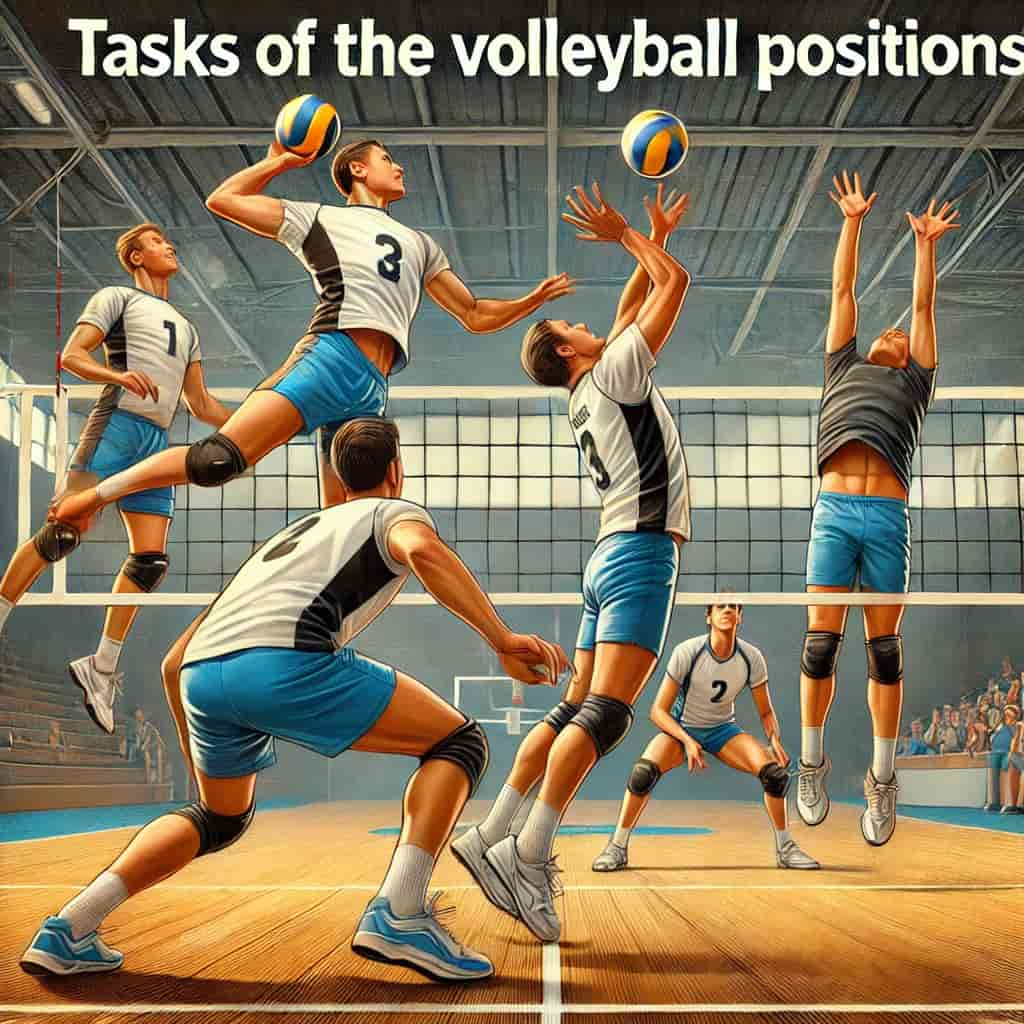![5-1 Volleyball Rotation [Top Strategies]](https://volleybhub.com/wp-content/uploads/2024/09/5-1-Volleyball-Rotation-Top-Strategies.jpg)
5-1 Volleyball Rotation (Introduction)
The 5-1 rotation in volleyball is a popular offensive strategy used globally, mainly due to its efficiency under the official rules set by the Fédération International de Volleyball (FIVB). According to FIVB guidelines, a team can make only 6 substitutions per set, and once substituted, a player cannot re-enter during that set.
This restriction makes mastering the 5-1 rotation advantageous as it demands that players be proficient in all positions, enhancing both flexibility and tactical depth.
Contrastingly, in the USA, Women’s NCAA and Junior Volley teams operate under different rules, allowing up to 12 substitutions per set. This higher limit facilitates more dynamic strategies and player rotations, providing continuous fresh play and opportunities for developing various tactical skills.
The tactical flexibility and the continuous learning it provides to coaches remain intriguing. The balance between player development and strategic depth under different substitution rules continues to evolve, presenting new challenges and insights into effective team management and player utilization.
Advantages of the 5-1 Volleyball Rotation
Consistency in Play: Employing a single setter in the 5-1 formation ensures consistent setting, which aids hitters in developing a reliable rhythm and timing for their attacks. This consistency is crucial for maintaining a steady offensive flow.
Enhanced Offensive Strength: This strategy maintains three front-row hitters at all times, maximizing the team’s offensive capabilities. It allows for a more versatile and aggressive approach to scoring.
Defined Roles and Improved Coordination: Clear, designated roles help players understand their responsibilities better, enhancing team coordination and reducing confusion during play.
Specialization of Roles: The 5-1 setup allows for the inclusion of a specialist setter, whose skills can significantly impact the team’s overall performance. This specialization in setting plays a critical role in diversifying the team’s offensive strategies.
Strategic Flexibility: The formation provides the flexibility to adapt to various playing styles and opponent strategies, offering freedom in strategic planning and player positioning.

Implementing a 5-1 Volleyball Rotation
Initial Setup
The 5-1 rotation starts with strategic player placement, crucial for balancing the team. Typically, the lineup includes:
- Setter (S)
- Two Middle Blockers (one stronger, M1, and one weaker, M2)
- Two Outside Hitters (one stronger, O1, and one weaker, O2)
- An Opposite (OPP)
This setup ensures a mix of skills on the court, aiming for three attackers in the front row for effective offense and blocking. The arrangement positions the stronger middle blocker and outside hitter adjacent to the setter to optimize the team’s strength and cover any defensive gaps, particularly if the setter is weaker at blocking.
Rotation Dynamics
Understanding the rotation mechanics is key to maintaining team balance and effectiveness. The 5-1 system requires knowledge of six serve-receive setups, with the setter’s position playing a critical role in the team’s formation and strategy. For example, when the setter is at the back, players in the front need to be ready to manage the first ball to allow the setter to transition smoothly into playmaking.
During serve rotations, the initial position of the setter can influence both offensive and defensive capabilities. Starting with the setter as the server is beneficial, allowing three front-row players who are strong at blocking to be ready.
Each rotation, from 1 to 6, demands specific player movements to optimize positioning for serves, setting, and attacks, such as the middle blocker serving from the left corner to facilitate easy integration into the defensive setup, and positional swaps between the setter and opposite to enhance attack setups.
Strategies for the 5-1 Volleyball Rotation
Front Court Offensive Tactics
In the front court, the setter’s role is pivotal to launching effective attacks:
- Attacking Role of the Setter: Positioned in the front court, the setter can directly attack the ball through techniques like setting dumps or net jousts, adding an element of surprise that challenges the defense.
- Enabling Middle Attacks: With the setter in the front, there’s increased room for middle blockers to execute behind-the-serve attacks, such as slides and complex combinations, enhancing the offense’s dynamism and unpredictability.
- Setter’s Strategic Influence: The front court position of the setter simplifies offensive setups, allowing closer coordination at the net and efficient use of two front-row attackers.
Back Court Offensive Tactics
The back court strategies capitalize on the setter’s role from a different angle:
- Protecting the Setter During Serve-Receive: The primary goal in back court rotations is to shield the setter from receiving the serve, ensuring they are free to orchestrate the attack, often involving strategic placements of other players for optimal serve reception.
- Adjusting for the Setter’s Absence: If the setter engages in the first contact defense, another player, typically a libero or defensive specialist, steps in for setting duties, maintaining the team’s offensive flow.
- Leveraging Back Row Attacks: With the setter in the back row, three front court attackers are poised to execute strategies like pipe or D attacks, diversifying and deepening offensive tactics.
- Strategic Player Substitutions: The 5-1 rotation’s minimal substitution rule allows for the strategic inclusion of a defensive specialist in the back court to bolster defense without significantly diminishing offensive power.

Defensive Tactics in the 5-1 Volleyball System
Defensive strategies in the 5-1 volleyball rotation blend tactical positioning with dynamic responses based on the setter’s court location, emphasizing a unified team effort and the crucial role of the libero in fortifying team defense.
Front Court Defense
In the front court, the defensive structure is closely tied to the setter’s position. Typically, a middle blocker and an outside hitter complement the setter in the front row. This arrangement may limit blocking options but allows for versatile defensive tactics. The middle blocker, positioned behind the setter, facilitates various defensive maneuvers. Adjustments in blocking strategies are necessary to optimize the contributions of the middle and outside hitters due to the setter’s positioning.
Back Court Defense
In the back court, the setter’s defensive role is more intricate. If positioned initially in the back court, the setter must quickly transition to a suitable setting position after receiving the service. Here, the libero plays a pivotal role, covering extensive ground and handling the first ball, which gives the setter the needed time to prepare for setting up attacks. Additionally, using tactical switches, such as the opposite hitter taking over defensive responsibilities from the setter on free balls, allows the setter to focus on play setup without immediate ball handling pressures.
Role of the Libero in the 5-1 Volleyball Rotation
In the 5-1 volleyball system, the libero is crucial for enhancing team defense:
- Primary Responsibilities: The libero’s main tasks include improving the team’s defense through skilled digs and comprehensive back court coverage.
- Serve Reception and Passing: Often, the libero is responsible for receiving serves and making the initial pass, particularly when the setter is positioned in the back court, ensuring the offensive flow is maintained.
- Defensive Coordination: The libero also plays a vital role in coordinating the team’s defense, especially when the setter is engaged in blocking or is out of position. This ensures that the team’s defense remains robust under various play conditions.
Read Also: What is the salary for a professional volleyball player?
Tailoring the 5-1 Volleyball Rotation for Various Skill Levels
Beginner Volleyball: For newcomers, simpler rotations like the 4-2 are recommended to help players develop basic skills without overwhelming them with complex strategies.
Intermediate Volleyball: As players enhance their skills, the 5-1 rotation becomes more applicable. It introduces a moderate level of complexity and strategic depth, preparing players for advanced volleyball tactics.
Advanced Volleyball: For those at an advanced level, rotations like the 6-2 cater to players with higher skill sets and tactical understanding, offering dynamic and challenging gameplay.
Recreational and Drop-in Volleyball: In casual or recreational play, the choice of rotation may vary based on the players’ skill levels and the overall goal of the game, focusing on enjoyment and participation over competitive strategy.
FAQ’s: 5-1 Volleyball Rotation
Why is it named the 5-1 rotation?
The 5-1 rotation in volleyball is so-called because it typically features one setter and five other players who are primarily attackers. The inclusion of a libero, who is a defensive specialist, slightly alters this configuration but does not change the foundational setup of one setter with five players focused on offensive roles.
How does the 4-2 rotation differ from the 5-1?
In the 4-2 rotation, there are two setters, and each one sets exclusively from the front court. By contrast, the 5-1 rotation employs a single setter who handles setting duties from both the front and back courts throughout the game, allowing for a more fluid and dynamic play style.
How is a 5-1 rotation managed with a shorter setter?
In a 5-1 rotation, the effectiveness of a shorter setter can be maximized by focusing on their ability to maneuver and jump efficiently, as the setter needs to contribute not just to setting but also to blocking and, occasionally, attacking. If there is an additional, taller setter available, they can be utilized primarily in the front court, allowing the shorter setter to focus on back court duties. This setup, while maintaining a single setter in play at any time, borrows elements from both the 5-1 and 6-2 rotations to adapt to the team’s strengths.





